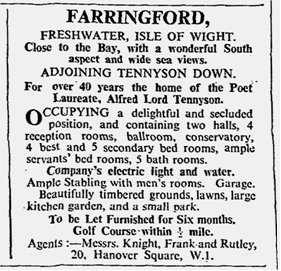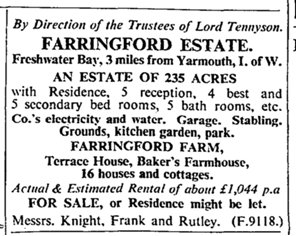Hallam Tennyson died in 1928, and Farringford ostensibly passed to his son, Lionel Tennyson. However, Lionel was reluctant to live in his childhood home, which by this time was in a poor state of repair with outdated facilities. Charles Tennyson was an Executor of Hallam’s will, and took on the considerable responsibility of modernising it: “the dark, rather dilapidated old house – ‘Wuthering Heights’, Augustine Birrell [Charles’ step-father] called it – could not be brought up to modern standards of living without substantial expenses”(Stars and Markets by Charles Tennyson. Chatto & Windus, 1957). A proper plumbing system and indoor bathrooms were added, while the oil lamps Hallam had insisted on were replaced by electric lighting.
Between 1933 and 1935 Farringford was the holiday home of Charles Tennyson and his family; during this time Charles sorted through the family papers, including correspondence, manuscript fragments and proof sheets. More substantial manuscripts had already been given to Alfred Tennyson’s alma mater, Trinity College, Cambridge, by Hallam. Charles would eventually give most of the material he collated to Harvard University.
From 1935, Farringford was being advertised to let (furnished) by Knight, Frank & Rutley, of Hanover Square, London. In one advert from December 1939 the house is described as comprising “two halls, 4 reception rooms, ballroom, conservatory, 4 best and 5 secondary bed rooms, ample servants’ bed rooms, 5 bath rooms”:

Advert 30/12/39 [159M88/53]
The house failed to garner much interest, and in 1940 it was being advertised for sale as well as rent in The Times:

Farringford was closed during World War II, and because it was not occupied by troops or used as a hospital, its treasures remained in the house. At some point – possibly during Charles’ occupancy – these were exhibited to the public in what is now known as the music room. However, most of these have been dispersed over time, with the most substantial collection of personal items being held at the Tennyson Research Centre in Lincoln https://www.lincolnshirearchives.org.uk/.
Based on the ‘Analytical Record’ of Farringford by Robert Martin: